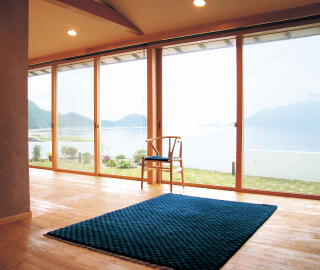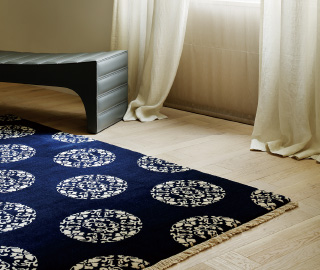INTRODUCTION

Tradition leads to a new aesthetic.
There was beauty on the vast Asian continent that once startled the rest of the world. Ceramics, textiles, sculpture these ultimately refined skills have been passed down to the present, and now they greet a new era. MUNI CARPETS have created carpets that fuse modern taste with the traditional skills underlying Eastern aesthetics. This is the unique value born from the harmony of "beauty" and "innovation".
CONCEPT / Realizing a Luxurious Style that Transcends the Eras

In the 1930s, a new, unprecedented interior style was born in Paris and New York, the centers of global culture.
That style, a fusion of Western modernism and Eastern traditional aesthetics, was sublimated into a more sophisticated form by high-end designers, and rapidly spread across the world.
The homes — or salons — of such people, where their individuality was expressed to the utmost, were also arenas for cultural exchange. Each and every item placed in these rooms was meticulously selected, and the knowledge of how to arrange them was a natural matter of taste.
Visitors to such salons would firstly direct their gaze at the furniture, then at the pictures hanging on the walls, and lastly turn their appreciation to the hand-woven carpet laid on the floor.
Exquisite Chinese carpets brought from the distant Orient, which no-one had laid eyes on before, were the ultimate finish to the perfect interior arrangement.
MUNI CARPETS has recreated the pinnacle of carpet manufacturing and traditional aesthetics of the Chinese Ming Dynasty called Classical Chinese Rugs, the original source of Eastern aesthetics, and updated them to suit modern times based on the concept of this most luxurious, chic interior style of the 1930s era.
We at MUNI provide our customers with a sophisticated interior style that is a novel fusion of modernism and the finest traditional aesthetics of the Orient.
STUDIO / The Atelier that Produces MUNI CARPETS
MUNI CARPETS established our atelier, 'Hanzhanju', in Gansu Province in Northwest China.
This location was chosen because long ago, it was the production area for the most outstanding carpets of the Chinese Ming Dynasty.
The highest-grade carpets, designed for use in the Imperial Court, were born from the refined culture of the Western Regions, exemplified by Dunhuang Art, as well as the finest quality wool raised in the bountiful natural environment of the upstream area of the Yellow River, and the meltwater of the Qilian Mountains, which greatly influenced the coloring of vegetable-based dyes. In this historical sacred place, MUNI CARPETS has revived time-honored traditional manufacturing methods in addition to updating the technology and designs in order to fit modern styles. Our unrivaled carpets, of a high quality that exceeds that of the original era, are produced entirely by the remarkable handwork of artisans, from the spinning of the yarn to dyeing and weaving.
QUALITY

After long years of research, MUNI CARPETS has revived from scratch the manufacturing methods of the pinnacle of carpet-making in the Chinese Ming Dynasty, and updated these methods to produce our carpets so that they can be used comfortably in accordance with the lifestyles of our customers in modern Japan.
For Japanese people, who take off our shoes inside our homes, the springiness of a carpet is an extremely important factor. Therefore, by weaving our carpets with an increased density of 'pounding', we have improved their resilience.
For example, when you spend time relaxing on the sofa, the carpet will support your feet comfortably with a high-grade resilience. When you make the most of your private space by sitting or lying on the floor, you will feel a heightened level of comfort, as the hardness of the floor is not directly transmitted to your body.
In Western countries, where people often keep their shoes on indoors, the quality of the wool is less of an issue, as one's feet do not make direct contact with the carpet. However, in Japanese daily life, the texture of a carpet is of a similar importance to clothing such as sweaters.
The wool used by MUNI CARPETS is a premium wool sheared from sheep known as 'Tan sheep'. With fine fibers of under 15 microns, equivalent to cashmere, there is no sense of abrasion when the wool touches your skin; it feels extremely pleasant when touched with bare skin. Wool has high heat-retentive properties due to the fact that it naturally contains large amounts of air, and since its surface remains dry even after absorbing sweat and humidity, wool carpets are cool in summer and can be enjoyed in comfort all year round.
Dyeing is conducted in accordance with Ming Dynasty-era methods: all the dyes we use are vegetable-based. Furthermore, no chemical substances are used at any stage of manufacturing, from dyeing to finishing, so you can enjoy our carpets with full peace of mind.
ART DIRECTION
PARTNER SHIP
Bill Zhang
Established the atelier 'Hanzhanju' with the objective of reviving Classical Chinese rugs, a tangible representation of the Silk Road culture. Zhang has had a deep love of Dunhuang Art since his years at university.
"Managing the atelier means nurturing the spirits of each individual artisan."
"We decided to take responsibility for proceeding with this project as two individuals from two nations, Japan and China. That was because we understand the importance of the traditional culture of carpet-making more than anybody else. Tradition does not just simply involve the skills of artisans. It means drawing on the mentality of our predecessors, and carrying it onwards to the future. This, I think, is the act of protecting tradition. In the twenty-first century, now more than ever, we should continue to protect tradition. That is my dream."

Bill Zhang
HISTORY / MUNI CARPETS' History

MUNI CARPETS began in 1987, when founder Kenji Kusudo encountered his first antique Chinese rug.
Kusudo, who was born into a long-established family of kimono fabric dealers, first took an interest in interior design as a university student. He became strongly attracted to interiors that are a fusion of Western modern styles, as introduced in overseas interior design magazines such as 'AD', and Eastern traditional aesthetics.
During his first visit to Hong Kong, Kusudo was able to find an antique Chinese rug, which was something that he had hoped to see for many years. He was deeply drawn to its beautiful patterns and matured indigo coloring that had intensified over time. As he proceeded to collect and research antique Chinese rugs, he learned about the masterpiece carpets referred to as 'Classical Chinese rugs', which were presented to the Imperial Court from the late Ming Dynasty to the early Qing Dynasty. Kusudo desired to revive these carpets, which were exquisite and of high cultural value, once more in the context of modern interiors. This deeply-held wish led him to encounter his business partner, Bill Zhang.
Bill Zhang shared Kusudo's aspiration, and joined him on his journey as a partner, in charge of managing the atelier where the kind of carpets Kusudo strove for would be manufactured. Then, in 1989, they took their first step in the project to revive Classical Chinese rugs. Kusudo and Zhang collected antique carpets in order to more faithfully recreate the pieces that were made long ago, and with cooperation from the Metropolitan Museum of Art, made repeated surveys and studies. After such a process of trial and error, they succeeded in reviving the traditional techniques such as hand-spinning, vegetable-based dyeing, and hand-knotting. By further improving these techniques and incorporating Japanese sensibilities and aesthetic sense, 'MUNI CARPETS' was born: high-quality carpets that can be used beautifully, in a modern way, and reliably, within today's Japanese lifestyle.
THE ORIGIN / MUNI CARPETS' Starting Point
Let us discuss Classical Chinese rugs, which form the roots of MUNI CARPETS. Even within the venerable history of Chinese carpets, these rugs possess a particularly outstanding elegance and sophistication. Known as 'Classical Chinese rugs', they were woven as gifts for presentation to the Imperial Court during the late Ming Dynasty and early Qing Dynasty (the sixteenth to eighteenth centuries), a period which bore a profound influence on Japanese arts and crafts.
With the decline of the Qing Dynasty, these carpets remained undisturbed deep within the Court. However, at the beginning of the twentieth century, as soon as Classical Chinese rugs were introduced to the West they were welcomed with the envious eyes of the upper classes, and immediately became a status symbol. The dignified Eastern aesthetics attracted top creators and celebrities in the West such as Louis Comfort Tiffany, Coco Chanel, Frank Lloyd Wright, John D. Rockefeller, and the rugs were used as important items to express the individuality of such people. Later, interior styles using Classical Chinese rugs were adopted by interior designers worldwide such as Frances Elkins in Los Angeles.
In the present day, this luxurious interior style has been preserved by leading interior designers in the West. The elegant styling of Giorgio Armani's Milan residence, which was worked on by Peter Marino in the 1980s, still continues to inspire many interior designers today.
Classical Chinese rugs have captivated the world, regardless of the era. However, since the nineteenth century, such traditional Eastern aesthetics have been gradually lost, and the rugs that have spread worldwide today through commercialist designs and mass production using machinery and chemical dyes are not those that have inherited the original traditional aesthetics.
The true Classical Chinese rugs made in the sixteenth to eighteenth centuries are, even today, kept in famous art museums in the West as treasures of the world. At MUNI, in order to pass down this valuable global culture of dyeing and weaving, we have investigated manufacturing techniques and patterns with the cooperation of institutions including the Metropolitan Museum of Art in New York and the Palace Museum in Beijing, and are manufacturing our MUNI CARPETS on the basis of historical research.

Letter to Kusudo written by the late Jean Mailey, curator at the Metropolitan Museum of Art.
Her warm encouragement and cooperation remain a strong source of support for Kusudo today.














